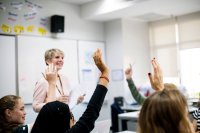Reducing Dependence on Slides
Focusing less on the slides and more on student discussion fosters deeper engagement.
In many professional settings and in schools, slideshows have become so pervasive that a meeting, training, or class rarely goes by without their presence. I recently observed a teacher reading directly from slides while students looked on without discussion or questions. Reliance on slides not only stifles engagement, but it may also remove student voices and critical thinking processes from the lesson.
While banning slideshows in schools is an unnecessarily drastic step to improving engagement, student and teacher focus may benefit from reducing slides and focusing on other forms of instruction. How can we walk back our dependence on slideshows?
Reduce and Edit Slides
First, put very little text on the slide itself. Think in bullet points rather than sentences. Paragraphs of text are more difficult to process, and not all of the information that students need should be on a slide. Instead, use hyperlinks or differentiate resources by providing materials in various modalities such as videos, podcasts, and visuals to provide supplementary lesson supports.
Think of the purpose behind any text as a basic sketch of ideas. For example, if students are learning how to abbreviate state names, rather than listing all state abbreviations on the slide, share only the most relevant information (i.e., that abbreviations are two letters long). Then give one or two examples to make the concept clearer. In-depth information can be part of exploration as the students delve into topics independently if they are provided a short reading piece or a video about state names.
Let Students Generate More Content
To ensure that students understand the concepts they learn about, make them part of creating lesson aids or materials. For example, if a class is learning about a historical time period, rather than listing facts, ask students to turn to one another and make a list of what they already know about the topic. Then, they can share with a whip-around (rotating through the class to gather a brief sampling of student responses).
If the day’s objective is to teach a new concept, find a skill that leads up to that concept and ask students to teach the background to one another. The teacher can observe how they unpack their knowledge and determine their readiness for the next steps. Making inductive and student-centered models part of the instruction not only reduces reliance on slideshows, but it also builds student confidence and lets students know that the teacher respects their contributions.
Prioritize Mastery Teaching Practices
Following a slide with “Any questions?” rarely yields responses. Instead, intentionally use open-ended questions that encourage higher-order thinking processes. Put one complex question onto the slide that houses the problem that requires a multiword answer. For example, if students are completing a word problem that asks them to calculate the amount of money that a babysitter earns based on an hourly rate, the slide might read, “If Susie babysits more than one child, should she be paid the same amount? How did you arrive at that decision, and how would it be calculated?” Then, students can work on the questions in pairs so that when it is time to share, everyone has an idea about how to respond.
Few learners are comfortable enough to take the risk of pausing the presentation to ask a question, so build in some wait times: one after asking a question and one after a student responds. Studies have shown that teachers typically wait less than one second after both asking a question and hearing a response to speak. Instead, count to five with intention and observe how much more students talk. By responding to students and their needs, and not to a preplanned set of slides, instruction will become more relevant and responsive.
Restructure the Class
In a literature class I took, the teacher would seat everyone in a circle and stare at us, waiting for students to talk about the assigned reading. After an awkward silence, we began to talk, and our teacher listened quietly. He took notes and observed our conversation to determine what we knew and what he should focus on. Because he gave himself time to observe the discourse without using a complex presentation or the board as a focal point, students slowly became more comfortable talking about the learning.
Engagement often begins with stronger connections among class participants, and slideshow presentations pull too much focus from human interaction. Instead, get away from the board. Sitting in a circle and asking students to begin a reading discussion by answering a question about a related topic rather than the specifically assigned content opens doors for involvement. Starting with an easier question allows students to engage before moving toward a more targeted conversation.
With each class we teach, we build a narrative centered on what makes each group of students distinct. An overuse of slides can have the effect of making each class look too much alike. Before launching into the work, talk about it: “Yesterday, you may remember that we had a hard time exemplifying the transitive property. What was holding us back? What should we do to clear that up today?” Metacognitive practices help students see their progress and part of the narrative.
Slides can be a helpful tool in the classroom, but reducing dependence on them can improve instruction and engagement.
